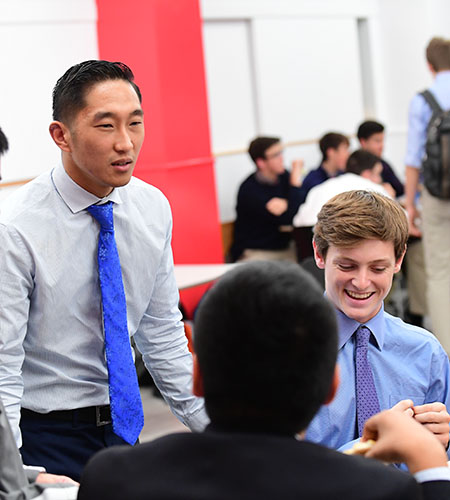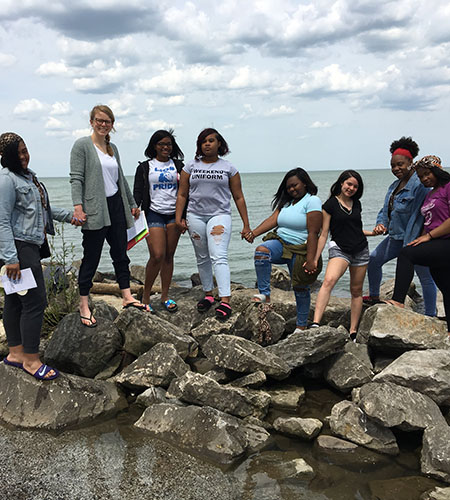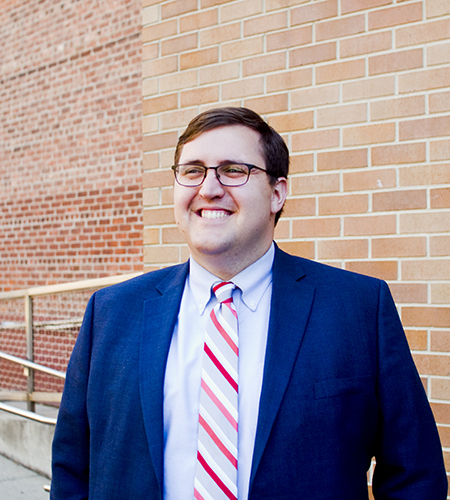Learn, lead, serve, and educate
Loyola alumni dedicate themselves to Jesuit education
The mark of a Loyola University Maryland education is how graduates share their education with others.
For the dozens of Loyola alumni in the Jesuit Schools Network—the network of North American Jesuit secondary and presecondary schools—that means providing the gift of a Jesuit education to new generations of students.
Loyola magazine reached out to a few of those alumni in different parts of the U.S. to ask them to share their thoughts on applying their Loyola education to serve this new generation of students in Jesuit schools.
The importance of discernment
Brendan O’Kane, ’07, and Justin White, ’09, work mere minutes from Loyola’s campus, at Loyola Blakefield in Towson, Md. They serve together in the middle and high school’s office of Ignatian mission and identity, O’Kane as the director and White as interim director of campus ministry.
“Loyola taught me how to discern,” White said, referring to the Ignatian process of prayerful decision making. His involvement in Loyola’s Center for Community, Service, and Justice particularly inspired his call to ministry. “The professional, personal, social, and spiritual development that I got through my years of working with the Center gave me the ability to discern what I wanted to do with my life.”

Loyola also helped O’Kane find his way, as his advisor, H. Lovell Smith, Ph.D., assistant professor of sociology, gave him the space he needed to discover this passion.
“I majored in sociology and really didn’t know what I was going to do,” he said. That was before he embarked upon a senior-year internship at St. Ignatius Loyola Academy. “Once I got into Jesuit education, that was it for me—I found my path and knew I wanted to stay.”
Understanding students as individuals
Farther north, Regis High School in New York City is home to another pair of Loyola graduates, Xavier Simon and Andrew Kent, both members of the Class of 2009. Simon, a biology teacher, said that his professors inspired the sort of teacher he strives to be.
“I feel lucky to have had teachers at Loyola who were passionate about their subjects, and were able to spark that same interest in their students,” he said. “They seemed to make a concerted effort to not only educate me as a student, but also understand me as a person.”

Kent, who serves as a theology teacher and an assistant dean, also spoke of how much his professors influenced him.
“My professors embodied in many respects the Jesuit ideals,” he said. “They sparked our curiosity from a very natural place.”
Campus Ministry also had a deep impact on Kent. “It attracted people who would willingly admit their brokenness, but also ruminate about their hope and care and justice, and really act upon them.”
Leaving your comfort zone
A short ride north on the 6 train brings you to the Hunts Point neighborhood of the Bronx, where Sage Fuller, ’18, is midway through her first year at St. Ignatius School. The Nativity school exclusively serves students from low-income families.
“I always knew that I wanted to teach, but I wasn’t sure what,” Fuller said. Her education classes coupled with her experience of student teaching helped her discover a passion for teaching middle school. Today, she teaches sixth-grade English language arts.
“I liked how Loyola focused on creating the student as a whole person and making them really well-rounded,” she said. “They took you out of your comfort zone to make you a better person.”
An unexpected path
Mary Carney Sayre, ’10, is in her eighth year at St. Martin de Porres High School in Cleveland, Ohio. St. Martin is a Cristo Rey school, where students from low-income families receive a Jesuit education while gaining valuable work experience through a corporate work-study program. Sayre is the director of student life, overseeing all athletics, extracurricular activities, and major student events such as dances and graduations.
As a math major and business minor at Loyola, Sayre never saw herself pursuing a career in education.
“Loyola taught me the importance of being open to not having the path already laid out, and being open to what God had in store.”
Sayre’s experiences of service at Loyola led her to do a post-graduate year with the Jesuit Volunteer Corps, which in turn led her to teaching. She is also grateful for her academic experience.
“My math major has strengthened my ability to problem-solve, think critically, and work logically in a sometimes crazy environment.”
Inspiring a love of learning
Their individual responsibilities may vary, but these alumni all have one thing in common: a desire to make a difference in the lives of their students.
“At the end of the day, I want to make sure young people feel their worth,” White said. “Our programming gives them an experience of freedom, and in that freedom they can think about what they want from life.”
“Most important for me is just trying to do my best to be a follower of Christ,” O’Kane said. “Trying my best to be a positive example of what it means to be Catholic.”

Simon hopes his students will develop a love of learning. “I want my students to not only understand how life works, but also how biology informs their daily lives—that they are not only intellectually proficient, but also curious learners in their life.”
For Kent, working as a Jesuit educator comes down to love, even in his role as a disciplinarian.
“I want my boys to know that I deeply care for them and pray for them outside of the classroom,” he said. “But because I care about them, there need to be rules that they follow, because it’s for their best benefit.”
Fuller and Sayre both work at schools that serve students with great economic need, coming from families often at or below the poverty line. This often means finding new and creative ways to give them the support they need to succeed.
“These kids work really hard—it’s really, really impressive to see,” Fuller said of her students at St. Ignatius School. She moderates an after-school leadership club. From the beginning she has tried to give her students an opportunity to step outside of their comfort zone—as she did at Loyola. “They were a pretty quiet group of kids, and over the first months of school, I’ve seen them become leaders.”
Possibly the most important trait that these alumni—and the dozens of others engaged in the work of Jesuit education—share is openness: openness to growth, to opportunities, and to further learning.
“Loyola really encourages you to continue to learn beyond just a class during your years of college,” Sayre said. “Learning never stops.”
Neither do Jesuit education, leadership, and service.
The author’s perspective
Loyola is the reason that I am a Jesuit educator today. While it wasn’t my first experience of Jesuit education (I am also a proud graduate of St. Joseph’s Prep in Philadelphia), my time at Loyola allowed me to take ownership of my faith and to discover where God was calling me. My involvement with Campus Ministry and the Center for Community, Service, and Justice helped me discover a deep desire to serve others, and my psychology major gave me the tools and skills I needed to turn that desire into action.

Today, as the director of Campus Ministry for St. Peter’s Prep, a Jesuit all-boys high school in Jersey City, N.J., my Loyola experience inspires how I serve my own students. I want to give them the same support, patience, guidance, and good humor that my mentors at Loyola—professors, professional staff, Jesuits, and peers—gave me.
Most importantly, I hope to give them the same opportunities that I had: opportunities to engage with the wider world, reflect on its joys and sorrows, and discern their place in it. Having those opportunities at Loyola changed my life, and helped me find my way. Passing them on is the least that I can do.